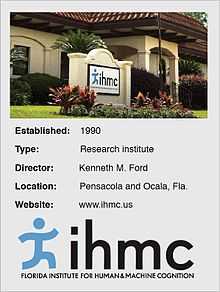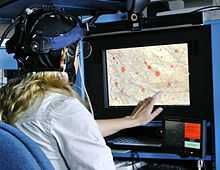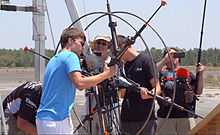Florida Institute for Human and Machine Cognition

The Florida Institute for Human & Machine Cognition (IHMC) is a not-for-profit research institute

of the State University System of Florida, with locations in Pensacola and Ocala, Florida. IHMC scientists and engineers investigate a broad range of topics related to building technological systems aimed at amplifying and extending human cognitive, physical and perceptual capacities. These include artificial intelligence, robotics, human-centered computing, agile and distributed computing and many related areas.[1][2]
History

1990—IHMC is founded as a research institute by Dr. Kenneth M. Ford and Dr. Alberto Cañas on the campus of the University of West Florida, growing primarily out of the computer science and psychology departments.[3]
2004—The Florida Legislature, under the K-20 Education Code, establishes IHMC as an independent, statewide research institute.[4] IHMC maintains affiliations with several Florida universities.[5]
2007—IHMC is recognized by the U.S. Economic Development Administration for the institute's impact on downtown Pensacola.[6]
2008 — IHMC director becomes chairman of the NASA Advisory Council.
2010—IHMC opens a new research facility in downtown Ocala in central Florida.[7]
2013—A team from IHMC competes in the Defense Advanced Research Projects Agency (DARPA) Robotics Challenge, placing first in the Virtual Robotics Challenge and second in the DRC Trials.[8] [9]
2014—An IHMC robot sets a new land-speed record for legged robots.[10] Also that year, DARPA awarded IHMC scientists a $3 million grant to research Big Mechanisms, using computers to analyze vast amounts of research and identify underlying mechanisms in complex systems.[11]
2015—IHMC breaks ground on a 30,000-square-foot building in downtown Pensacola, with expanded laboratories, research areas and offices.[12] Also this year, IHMC senior research scientist Jerry Pratt is named to the Florida Inventors Hall of Fame.[13]

Current research
IHMC’s human-centered research is focused on the development of technological systems designed to amplify human cognitive, physical, and perceptual abilities.[14] [15]
Research areas include biologically-inspired robotics, including humanoids and exoskeletons;[16] human-centered interfaces and displays;[17] artificial intelligence;[18] adjustable autonomy; knowledge modeling and sharing; human-machine teamwork, collaboration and coordination; communication, information management and dissemination in challenging networked environments; software agents; expertise studies; computer and network security; natural language understanding; work-practice simulation; knowledge representation; agile and distributed computing;[19] trust in autonomy; and concept mapping.[20]
IHMC has received research funding from government and private-sector sources, including DARPA,link the National Science Foundation, NASA, Army, Navy, Air Force, National Institutes of Health, and other agencies, foundations and companies.[21]
Scientific & Technical (S&T) staff

IHMC is home to more than 100 researchers and technical staff, many of whom are leading figures in their research fields.[22] Six researchers associated with IHMC have been named fellows at the Association for the Advancement of Artificial Intelligence.[23] Four people affiliated with IHMC have been inducted as fellows into the National Academy of Inventors.[24]
Facilities
IHMC has research facilities at both its Pensacola and Ocala locations.
Outreach

IHMC sponsors a number of outreach efforts in the local community, including a public Evening Lecture Series in both Pensacola and Ocala. The series has hosted dozens of notable speakers and in 2011 was recognized by STEMflorida Inc., a not-for-profit group that promotes science, technology, engineering and math education. IHMC also supports local education through programs such as its Science Saturdays, I LOVE Science, and robotics open houses and summer camps.[25]
See also

References
- ↑ "Manning up: IHMC Explores the Intersection of Man and Machine." January 2013. AUVSI Magazine.
- ↑ Hamilton, Scott. "Thinking Outside the Box at the IHMC". Computer , January 2001. (Los Alamitos, CA: IEEE Computer Society Press).
- ↑ Kenneth M. Ford, et al. "Coordinating Behavior of Distributed Systems," AI Magazine, Summer 2010. Also: State University System of Florida, Board of Governors; online publication.
- ↑ Florida Statute 1004.447.
- ↑ State University System of Florida, Board of Governors. Online publication.
- ↑ U.S. Economic Development Administration / U.S. Department of Commerce; online publication.
- ↑ Barnett, Cynthia. "Human, Machine Research Institute Joins Ocala's Downtown". Florida Trend. Summer 2010.
- ↑ Davis, Brett. "Robots Open Doors and Drive Cars and Chop Through Walls And..." Unmanned Systems Magazine, Association for Unmanned Vehicle Systems International, September 2013. Also: Markoff, John. "Japanese Team Dominates Competition to Create Generation of Rescue Robots". New York Times. Dec. 22, 2013. Also: "Robotics Challenge Teams to Compete for $2 Million Top Prize." AUVSI News. Mar 5, 2015.
- ↑ "Team IHMC's Lessons Learned from the DARPA Robotics Challenge Trials". Journal of Field Robotics. March 2015.
- ↑ Ackerman, Evan. "This Is What DARPA's Robot Ostrich Will Look Like". IEEE Spectrum. Nov. 14, 2011. Also: "IHMC robot sets world speed record," IHMC website.
- ↑ “Big Mechanisms Seeks the ‘Whys’ Hidden in Big Data.” DARPA webstie, Feb. 20, 2014. Also: Cohen, Paul R. “DARPA’s Big Mechanisms Program.” DARPA online publication.
- ↑ "IHMC breaks ground on new 30,000-square-foot-building." Pensacola News Journal. (Feb. 9, 2015).
- ↑ Florida Inventors Hall of Fame web page. http://www.floridainvents.org
- ↑ "Manning up: IHMC Explores the Intersection of Man and Machine." AUVSI Magazine. January 2013.
- ↑ You, Jia. "DARPA Sets Out to Automate Research". Science Magazine. January 2015.
- ↑ "NASA and IHMC Develop Robotic Exoskeleton for Space and Possible Use on Earth". NASA News; online publication. Oct. 11, 2012. Also: "Development of the IHMC Mobility Assist Exoskeleton". IEEE International Conference on Robotics and Automation, May, 2009.
- ↑ Hoffman, R., et al: "The Borg Hypothesis." Computer.org/Intelligent; IEEE Computer Society. September/October 2003.
- ↑ Kenneth M. Ford, et al. "Coordinating Behavior of Distributed Systems," AI Magazine. Summer 2010. Also: Kenneth M. Ford, Patrick Hayes. "On Computational Wings. Rethinking the Goals of Artificial Intelligence." Scientific American Presents: Machine Intelligence, 1998.
- ↑ Tortonesi, M., et al. "Multiple UAV Coordinate and Communications in Tactical Edge Networks," IEEE Communications Magazine, Vol 50, Issue 10. October 2012.
- ↑ Robert R. Hoffman, et al. "A Method for Eliciting, Preserving, and Sharing the Knowledge of Forecasters." Wea. Forecasting. 2006.
- ↑ Bradshaw, Jeffrey M. "Invited Talk: Human-Agent Teamwork in Cyber Defense". Multiagent System Technologies: 10th German Conference, October 2012.
- ↑ Kenneth M. Ford, et al. "Coordinating Behavior of Distributed Systems." AI Magazine. Summer 2010. Also: "People / Scientific and Technical". IHMC web page.
- ↑ Association for the Advancement of Artificial Intelligence. The Fellows List. http://www.aaai.org/Awards/fellows-current.php.
- ↑ National Academy of Inventors. NAI Fellows List. http://www.academyofinventors.org.
- ↑ National Robotics Week web site; 2015 Events; iRobot Corp. http://www.nationalroboticsweek.org/events.php
Further reading and viewing
- Watch six-legged robot run as fast as a car. CBS News.
- Sweep the Leg! Atlas Humanoid Robot Shows 'Karate Kid' Moves. NBC News (video)
- U.S. military building robotic ostrich for recon, search and rescue. VentureBeat.
External links
- Official website
- Researchers
- Evening Lecture series
- CmapTools
- Team IHMC at the DARPA Robotics Challenge